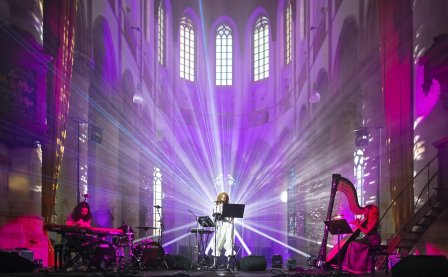The New Sacred
What is it that makes Ferraro, Lopatin, and Blunt’s music so interesting and, what’s more, so definitively of the moment?
One answer to that question, we think, might be that they have all been able to move so successfully beyond the sort of self-reflexive handwringing and ironizing outlined above. Like the teenyboppers, Gaga, Jay Z, Yen Tech, and the pastichers at DIS, these artists’ music has a certain “aboutness” to it. But it also has something else: a kind of artfulness, a sublime or even sacred quality, which has more in common with, say, Mozart or Talk Talk than most of the music currently being made by their peers. It is a kind of anachronistic affinity with the tropes of religion and romanticism in combination with musical strategies more familiar to sample-culture and postmodernism that marks Ferraro, Lopatin, and Blunt out.
Listen again to R Plus Seven. Notice the prevalence of what sounds like (but is not) a church organ. Notice the way in which Lopatin’s juxtaposition of that organ sound with all the various chintzy presets serves both to level the playing field, to reveal the organ as just another preset, no more or less sacred than the rest, but also — and crucially — to draw on the seriousness it derives from its association with the church to give weight to his entire project of leveling. The message conveyed by this seriousness is that the leveled palette of high and low culture deployed in Lopatin’s work is itself a new platform for musical experimentation, a transcendental plain. And sure enough, in September 2013, Lopatin did in fact perform the album in a church in Brooklyn to a congregation of fans in thrall to its very real beauty.

James Ferraro is less optimistic. As we suggested above, his work since Far Side Virtual could be read as a whole: an expanding series of pictures depicting the sonic equivalences between high and low culture. For Lopatin, the endpoint of this journey is artistic possibility; however, in NYC, HELL 3:00 AM, this plain seethes with apocalyptic menace, linking the confusion of pop and non-pop with the decrepit commercialism of the city that never sleeps, New York City. The album opens with a drawling, mechanical voice — “money, money, money.” The transcendental plain of artistic possibility is, for Ferraro, that of capital. What for Lopatin is Heaven, for Ferraro is Hell.
Dean Blunt is, again, by far the hardest to pin down. Nonetheless, his recent releases are clearly gesturing in this direction — not only was the cover of The Redeemer adorned with a set of praying hands, but also its language deals explicitly with religion: “Seven Seals of Affirmation,” “Walls of Jericho,” “Demon,” “All Dogs Go to Heaven,” etc. And, as we’ve already discussed, the album plays more than his work ever has before with classically “beautiful” sounds: from stirring strings to lilting folk ballads, to the sample from the Rites of Spring on “Six” from Stone Island and the harp and choir voicings on “Eight.” For Blunt, this is not just one more element in the chain of confusing signification that makes his music so relentlessly interesting, but also what makes him always feel one step ahead.
Conclusion
Finally, then, the leveling of pop and non-pop along with the conceptual turn has led not only to music that is endlessly “about” itself (which can get old quickly), but also something else, something better and more interesting: a new sacredness, which is to say something beautiful and/or terrifying, a suggestion that the new conceptualism itself has something bigger at stake, a transcendental artistic value, or a sublime failure.
The conceptual turn we have described here, just as with the turn to history we described in our last essay, is not an argument about the end of history or the end of music, or anything so dramatic. Instead, what we are saying is that the best contemporary music is interesting precisely because it is not just making new sounds, but also interrogating the very conditions under which it is produced, and moreover deploying these discoveries to take music in exciting new directions.
More about: ADR, Daniel Lopatin, Dean Blunt, Gatekeeper, James Ferraro, Yen Tech



